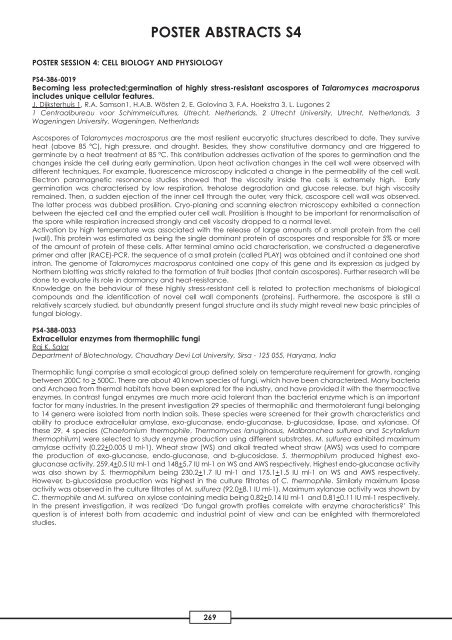Handbook Part 2 - International Mycological Association
Handbook Part 2 - International Mycological Association
Handbook Part 2 - International Mycological Association
Create successful ePaper yourself
Turn your PDF publications into a flip-book with our unique Google optimized e-Paper software.
POSTER ABSTRACTS S4<br />
POSTER SESSION 4: CELL BIOLOGY AND PHYSIOLOGY<br />
PS4-386-0019<br />
Becoming less protected;germination of highly stress-resistant ascospores of Talaromyces macrosporus<br />
includes unique cellular features.<br />
J. Dijksterhuis 1, R.A. Samson1, H.A.B. Wösten 2, E. Golovina 3, F.A. Hoekstra 3, L. Lugones 2<br />
1 Centraalbureau voor Schimmelcultures, Utrecht, Netherlands, 2 Utrecht University, Utrecht, Netherlands, 3<br />
Wageningen University, Wageningen, Netherlands<br />
Ascospores of Talaromyces macrosporus are the most resilient eucaryotic structures described to date. They survive<br />
heat (above 85 ºC), high pressure, and drought. Besides, they show constitutive dormancy and are triggered to<br />
germinate by a heat treatment at 85 ºC. This contribution addresses activation of the spores to germination and the<br />
changes inside the cell during early germination. Upon heat activation changes in the cell wall were observed with<br />
different techniques. For example, fluorescence microscopy indicated a change in the permeability of the cell wall.<br />
Electron paramagnetic resonance studies showed that the viscosity inside the cells is extremely high. Early<br />
germination was characterised by low respiration, trehalose degradation and glucose release, but high viscosity<br />
remained. Then, a sudden ejection of the inner cell through the outer, very thick, ascospore cell wall was observed.<br />
The latter process was dubbed prosilition. Cryo-planing and scanning electron microscopy exhibited a connection<br />
between the ejected cell and the emptied outer cell wall. Prosilition is thought to be important for renormalisation of<br />
the spore while respiration increased strongly and cell viscosity dropped to a normal level.<br />
Activation by high temperature was associated with the release of large amounts of a small protein from the cell<br />
(wall). This protein was estimated as being the single dominant protein of ascospores and responsible for 5% or more<br />
of the amount of protein of these cells. After terminal amino acid characterisation, we constructed a degenerative<br />
primer and after (RACE)-PCR, the sequence of a small protein (called PLAY) was obtained and it contained one short<br />
intron. The genome of Talaromyces macrosporus contained one copy of this gene and its expression as judged by<br />
Northern blotting was strictly related to the formation of fruit bodies (that contain ascospores). Further research will be<br />
done to evaluate its role in dormancy and heat-resistance.<br />
Knowledge on the behaviour of these highly stress-resistant cell is related to protection mechanisms of biological<br />
compounds and the identification of novel cell wall components (proteins). Furthermore, the ascospore is still a<br />
relatively scarcely studied, but abundantly present fungal structure and its study might reveal new basic principles of<br />
fungal biology.<br />
PS4-388-0033<br />
Extracellular enzymes from thermophilic fungi<br />
Raj K. Salar<br />
Department of Biotechnology, Chaudhary Devi Lal University, Sirsa - 125 055, Haryana, India<br />
Thermophilic fungi comprise a small ecological group defined solely on temperature requirement for growth, ranging<br />
between 200C to > 500C. There are about 40 known species of fungi, which have been characterized. Many bacteria<br />
and Archaea from thermal habitats have been explored for the industry, and have provided it with the thermoactive<br />
enzymes. In contrast fungal enzymes are much more acid tolerant than the bacterial enzyme which is an important<br />
factor for many industries. In the present investigation 29 species of thermophilic and thermotolerant fungi belonging<br />
to 14 genera were isolated from north Indian soils. These species were screened for their growth characteristics and<br />
ability to produce extracellular amylase, exo-glucanase, endo-glucanase, b-glucosidase, lipase, and xylanase. Of<br />
these 29, 4 species (Chaetomium thermophile, Thermomyces lanuginosus, Malbranchea sulfurea and Scytalidium<br />
thermophilum) were selected to study enzyme production using different substrates. M. sulfurea exhibited maximum<br />
amylase activity (0.22+0.005 U ml-1). Wheat straw (WS) and alkali treated wheat straw (AWS) was used to compare<br />
the production of exo-glucanase, endo-glucanase, and b-glucosidase. S. thermophilum produced highest exoglucanase<br />
activity, 259.4+0.5 IU ml-1 and 148+5.7 IU ml-1 on WS and AWS respectively. Highest endo-glucanase activity<br />
was also shown by S. thermophilum being 230.2+1.7 IU ml-1 and 175.1+1.5 IU ml-1 on WS and AWS respectively.<br />
However, b-glucosidase production was highest in the culture filtrates of C. thermophile. Similarly maximum lipase<br />
activity was observed in the culture filtrates of M. sulfurea (92.0+8.1 IU ml-1). Maximum xylanase activity was shown by<br />
C. thermophile and M. sulfurea on xylose containing media being 0.82+0.14 IU ml-1 and 0.81+0.11 IU ml-1 respectively.<br />
In the present investigation, it was realized ‘Do fungal growth profiles correlate with enzyme characteristics?’ This<br />
question is of interest both from academic and industrial point of view and can be enlighted with thermorelated<br />
studies.<br />
269









